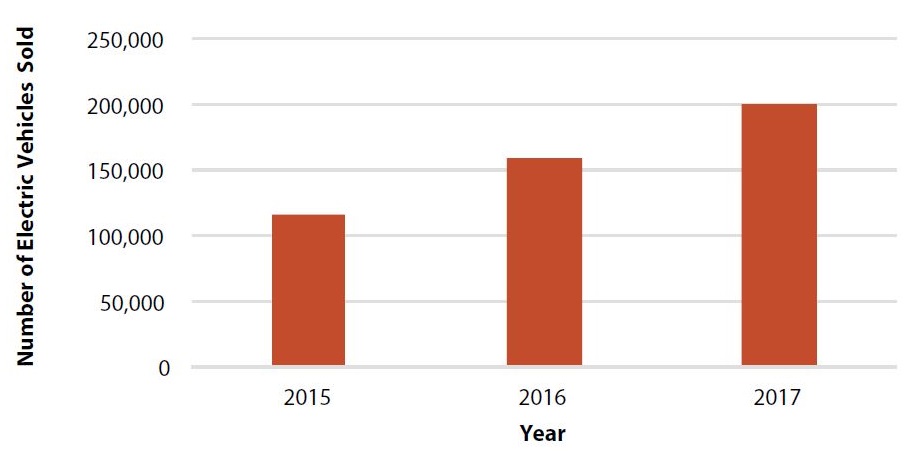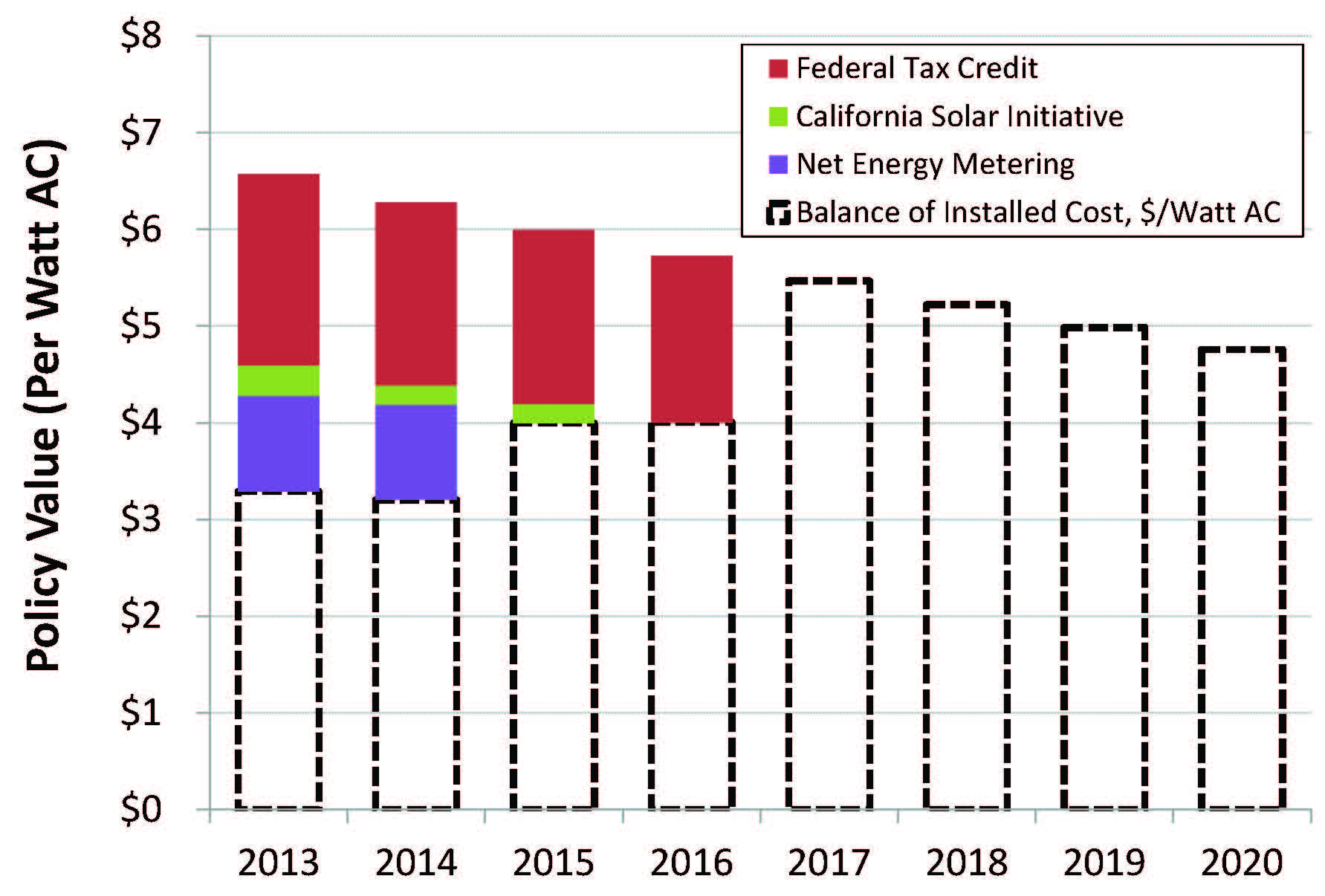California is building a clean energy future based on the efficient use of renewable resources that will never run out, like the sun. As of July 2013, the state has more than 1,600 megawatts of solar power capacity installed on or near buildings. At the peak of the sunniest days, these solar panels produce more electricity than a large nuclear reactor. If the state were a nation unto itself, it would rank 10th in the world in terms of its ability to generate electricity from rooftop solar panels.
California’s progress is due to forward-looking policies that are helping the state reduce its contribution to global warming, expand its use of local renewable energy sources, increase the reliability of electricity service, and control energy costs. In particular, net energy metering has been instrumental in the growth of California’s rooftop solar market. Net energy metering enables solar panel owners to earn fair compensation for benefits that they provide to other users of the electricity grid. Net energy metering is especially important for the residential solar market – and thus a key part of developing a more localized, reliable and efficient electricity system.
However, California regulators are now deciding whether or not to close the net energy metering program after the end of 2014. For some homeowners, ending net energy metering would reduce available cash flow from a solar energy system by about 20 percent over the lifetime of the panels, dissuading many from going solar. Ending net energy metering would cut against the momentum that California residents and businesses have invested billions of dollars since 2006 to create. Instead, regulators should widen access to net energy metering and eliminate regulatory barriers to the expansion of solar energy.
Net energy metering plays a critical role in providing access to solar energy.
- Traditionally, power companies have generated electricity at central power plants and distributed it to passive consumers over long-distance power lines. However, with the rise of rooftop solar technology, consumers can also be electricity producers.
- Electricity rate plans were not originally set up to accommodate self-generation. Net energy metering works to correct this by ensuring that solar panel owners are fairly compensated for the power that they supply to other users of the electricity grid.
Net energy metering is an important part of a healthy residential solar market.
- Practically every residential solar energy system in California takes advantage of net energy metering, which allows the customer’s power meter to “spin backwards” at times when solar power production exceeds on-site needs.
- With net energy metering, on-site demand for power and the availability of solar energy do not have to happen at exactly the same time in order for the solar panels to provide value. This is particularly important for residential customers, because homes tend to use the most energy in the afternoon and early evening, while solar panels produce the most power at mid-day.
Net energy metering improves the cost-benefit calculation for homeowners considering the addition of a solar power system, encouraging more people to adopt the technology.
- Net metering requires utilities to credit solar panel owners for providing excess power at the same price as delivered electricity, rather than a much lower wholesale rate. For an example homeowner in San Diego, a 2.8 kilowatt solar energy system under net energy metering would deliver 25 percent more electricity bill savings over 25 years – about $2,800 in net-present-value dollars – compared to the same system without net energy metering.
- Net energy metering makes solar energy a better deal. With net energy metering, an example homeowner installing solar panels in 2015 would be able to pay back the initial cost in about 9 years. Without net energy metering, time required to pay back the initial investment would extend to about 12 years.
- In addition, net energy metering enables homeowners to install solar systems capable of zeroing out a large part of their monthly energy bill. Without this policy, homeowners would have an incentive to undersize a solar system so that it never produced more electricity than could be used on-site at any given time. Such undersized systems might only be able to offset half to three-quarters of a home’s annual electricity consumption, wasting otherwise useful rooftop space.
Net energy metering is fair, providing economic and social benefits for both solar panel owners and other users of the electricity grid.
- All kinds of people have solar energy systems and therefore benefit from net energy metering, including low-income families. More than 2,800 low-income homeowners and multi-family dwellings in California have solar energy systems.
- Net energy metering provides broad benefits to all electricity customers, not just those who own solar panels. Studies by the California Public Utilities Commission and third-party energy analysts show that solar electricity helps prevent costs associated with generating and transmitting that power from other sources. Investing in rooftop solar technology reduces and delays the need to invest in new power generation and transmission infrastructure. It also reduces loads on long distance transmission lines and improves the overall efficiency of the electricity system. Increased solar power can lead to more reliable and less expensive electricity service. Studies show that these financial benefits of net energy metering roughly balance out the cost of the policy to ratepayers.
- By facilitating the growth of the solar energy market, net energy metering provides additional benefits to all of society, including increased energy security, reduced pollution, better public health, water conservation and the creation of local jobs that cannot be outsourced.
The expiration of solar incentive programs and approaching limits to net energy metering would slow the future growth of the solar market.
- A major 30 percent federal tax credit for solar energy systems is set to expire in 2016. Moreover, the incentive payments offered under the California Solar Initiative and related programs will expire sometime in 2015 or 2016, when utilities reach their share of the state’s goal of 3,000 megawatts of distributed solar power capacity.
- Limits to net energy metering are also approaching. The California Public Utilities Commission is now considering ending the net energy metering program after the end of 2014. Additionally, California has capped net energy metering participation at 5 percent of aggregate customer peak demand, which is roughly equivalent to 5,000 megawatts of solar power capacity statewide. At current rates of growth, this cap would limit the expansion of the state’s distributed solar energy market, especially the residential market, sometime after 2016.
- Suspending net energy metering would reduce a potential customer’s rate of return on an investment in solar power. The impact would be comparable to increasing the net cost of a solar energy system for an example solar customer by one-third in 2015. (See Figures ES-1 and ES-2.)
- Small changes in rates of return on investment in rooftop solar energy systems can have large effects on both the speed and the overall extent of market development. For example, researchers at the National Renewable Energy Laboratory estimate that valuing all electricity generated by residential solar panels at the wholesale cost of natural gas generation would reduce projected residential solar energy development through 2030 by 80 percent.
Figure ES-1: Schedule of Expiration for Solar Policies. Scenario A – Net Energy Metering Continues*
Figure ES-2: Schedule of Expiration for Solar Policies. Scenario B – Net Energy Metering Suspended After 2014*
Extending net energy metering beyond 2014 would help ensure that the solar energy market continues to grow in an orderly fashion.
- Net energy metering is a necessary part of a healthy solar energy market. The California Public Utilities Commission (CPUC) should allow new participants to join the net energy metering program after 2014. Additionally, it should lift the current 5 percent cap on participation in the program, ensuring that customers who go solar continue to receive fair financial value for the clean energy they feed back onto the grid.
- In addition, policymakers should eliminate regulatory barriers to the expansion of solar energy, provide access to more financing options for would-be solar customers, and require new buildings to meet net-zero energy performance standards.
* Data are for an example homeowner in San Diego installing a 2.8 kilowatt (AC) solar energy system, ignoring potential financing costs. These charts assume that solar energy systems will decline in price at a rate of 4.5 percent per year, per the residential solar reference scenario of the U.S. Department of Energy report SunShot Vision Study, February 2012. For the purposes of illustration, net energy metering is included in these figures as the net present value of 25 years worth of electricity supplied to the grid credited at delivered value rather than a much lower short term avoided cost rate. In real-world operation, net energy metering largely does not affect the up-front cost for a solar energy system.


